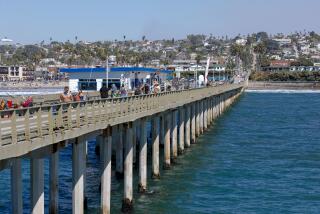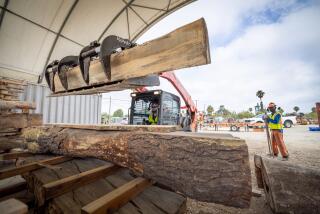COVER STORY : The historic piers of Southland beach cities are much more than docks and fishing platforms. They are. . . : Spans of Land, Sea and Time
We are perched on the westernmost side of the continent, at the very water’s edge, and yet somehow it still isn’t quite far enough.
So we build piers.
They jut from Long Beach and most other beach cities, fingers of wood or concrete reaching out to the sea. For more than a hundred years we have built them, enjoyed them, watched them get knocked down by waves or fires, and then built them up again. No matter how well-built they are, no matter how many tons of concrete or miles of reinforcing steel are put into them, someday the piers will crumble and topple, a victim of time and salt and pounding waves. But eventually, the piers will rise again. It’s a constant cycle of construction and destruction and reconstruction.
We’re in a reconstruction cycle now.
In Long Beach, officials plan to spend more than $1 million next year sprucing up the city’s only remaining pier, a corroding concrete structure at the foot of 39th Street in Belmont Shore. A new pier has been proposed downtown at the foot of Pine Avenue, the same spot where the city’s grandest pier once stood.
New or newly renovated piers are also busting out all over the South Bay.
In Redondo Beach, city officials plan to open the new Municipal Pier this month, seven years after storms and a fire dumped much of the old horseshoe-shaped pier into the ocean. In Hermosa Beach, plans are being formulated to renovate that city’s 30-year-old fishing pier with new railings, beacons, a snack shop and, maybe, a lighted neon tube running the pier’s entire 1,140-foot length. In Manhattan Beach, a restoration of that city’s 928-foot, 1920s-vintage concrete pier, including the Roundhouse at the end, was completed two years ago.
It’s an important process, this pier renewal, more important than simply providing platforms for fishermen or diners or strolling lovers. Because piers reflect as well as define the cities that they connect to the sea.
“In many ways a pier provides an identity for a community,” says James Crumpley, of Moffatt & Nichol Engineers in Long Beach, who has designed piers up and down the West Coast. “Sometimes you can tell a lot about a community just by looking at its pier.”
*
In short, piers are simultaneously a connection to the past and a vision for the future. In Long Beach, avid seaman Steve Christman wants to build a unique “floating pier” as part of the city’s ambitious $557-million Queensway Bay waterfront development downtown. The pier, connected to floats that are anchored to the ocean’s floor instead of being supported by pilings, would become the permanent home for the tall ship Californian, which is now tied up near Shoreline Village. The structure would accommodate visiting tall ships from around the world.
“Imagine seeing the mast of a 145-foot-long tall ship at the foot of Pine Avenue every day,” says Christman, president of the California Nautical Heritage Society. “Nothing would be more beautiful.”
His proposal also calls for an outdoor theater to stage plays with nautical themes, such as “The Pirates of Penzance” and “H.M.S. Pinafore,” a maritime museum and a large, open area for shipbuilding classes and demonstrations.
“My idea is for a working pier, like Pier 49 in San Francisco, where ships and their crews could actually come and go, and use the facilities,” says Christman, who has sailed up and down the California coast dozens of times.
City officials have endorsed the $1.3-million floating pier, but say they are unable to help fund the project. Robert Paternoster, who is managing the Queensway Bay project, is helping the Nautical Heritage Society drum up financial support through private donations and government grants.
“We’d like to see their pier in the harbor,” Paternoster says. “It would help create the character that we are looking for.”
Although there is no pier now in downtown Long Beach, for more than a century piers of varying shapes and sizes stretched out from the shore, luring ocean lovers for a stroll to take in the intoxicating sea air.
The first pier was built at Magnolia Avenue in 1885 by the Long Beach Land and Water Co. in hopes of attracting visitors to the developing coastal community. The short-lived pier, which consisted of simple wooden planks and narrow pilings, washed to sea during wild Arctic storms in 1900.
By that time, a pier had cropped up at the foot of Pine Avenue. It was the first municipal pier in California--paid for and owned by the city of Long Beach. The downtown pier became such a popular attraction in the early part of the century that city officials added an open-air pavilion, then a second deck. Scores of summertime visitors arrived by Red Car from Los Angeles to see the Long Beach coast and the two-story pier.
The Pine Avenue Pier also became a regular site for sea festivals, beauty pageants, parades and Bible readings. It was home to the Spit and Argue Club, a sort of speaker’s corner where men regularly debated topics of the day.
But, like other piers up and down the coast, Pine Avenue Pier suffered its share of natural and man-made catastrophes, only to be repaired and rebuilt.
A violent storm in 1904 delayed construction of its top deck. Powerful waves slammed into its pilings and washed away a portion of its lower deck.
The second deck finally opened later that year, but within months the wooden pavilion burned to the ground. The pier was closed for several months while the pavilion was replaced with a sun parlor at the tip of the pier. The parlor became the perfect spot for the city’s socialites to see and be seen.
A decade later, the upper deck collapsed during a festival. Fifty celebrants were killed and dozens more injured. City officials advocated tearing down the structure, but residents rallied around the popular landmark, raising thousands of dollars to pay for repairs. The pier reopened in 1915 and remained open for 16 years.
In 1931, it was torn down to make way for the horseshoe-shaped Rainbow Pier, which arched from Linden Avenue to Pine Avenue and cradled the city’s original Municipal Auditorium. It was the first California pier to cater to motorists as well as strollers.
Barbara Barnes still treasures the evening strolls she took with her parents on the pier in the early 1940s. World War II was in full swing and Long Beach was a bustling Navy town. But the global troubles seemed a million miles away to Barnes and her family, she says, when they were together on the pier.
“You’d walk out there and get all the fresh air and the smell of the ocean, and it was like being in another world,” recalls Barnes, 61, a lifelong resident of Long Beach. “There was nothing like it on a hot summer’s night.”
Barnes, who is now president of the Historical Society of Long Beach, is helping preserve the memories of growing up in the seaside city. Fuzzy black-and-white photographs of the old piers are being catalogued by computer at the historical society’s downtown office.
Barnes says she’d like to see another pier at Pine Avenue, but worries that perhaps times have changed too much.
“I think I’d probably be afraid to walk out there these days,” she says, shaking her head. “It’s not safe anymore. It’s easy for us to remember the good times, but some of the things we have lost just can’t be replaced.”
The city’s only existing pier is a squat, concrete structure that opened in 1968 in Belmont Shore. It replaced a battered, worm-eaten pier that had been built 50 years earlier.
The $1.5-million pier typified the architectural trend of the day--a T-shaped symmetrical design with a sleek octagonal structure at the end. Its distinctive, pointy-edged benches looked like something out of a Buck Rogers comic book.
These days, however, the Belmont Pier looks more like a monument to a bygone era. A breakwater protects it from the battery of storms that buckled earlier piers, but the paved walkway is cracked and stained, the wooden handrails are decayed and the erstwhile futuristic benches are crumbling.
Next fall, much of the worn facade will be repaved and repaired, and the octagonal snack bar and tackle shop is likely to be replaced with a more upscale, sit-down restaurant.
Dennis Eschen, the parks and recreation superintendent heading the pier renovation project, downplays the structure’s tired-looking exterior.
“To us, it’s a beautiful pier, and it’s a great place to sit and watch the sunset over Palos Verdes,” Eschen says. “It just needs some work.”
The pier’s steel-reinforced infrastructure is intact, Eschen says. The pier will probably remain standing well into the next century. To him, that is good news.
“I can’t imagine this city without a pier,” he says. “It’s always had one. It keeps us in touch with our beach heritage and our history, and that’s important.”
More to Read
Sign up for Essential California
The most important California stories and recommendations in your inbox every morning.
You may occasionally receive promotional content from the Los Angeles Times.










